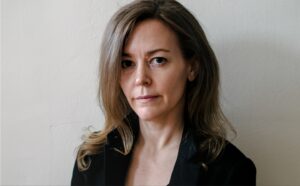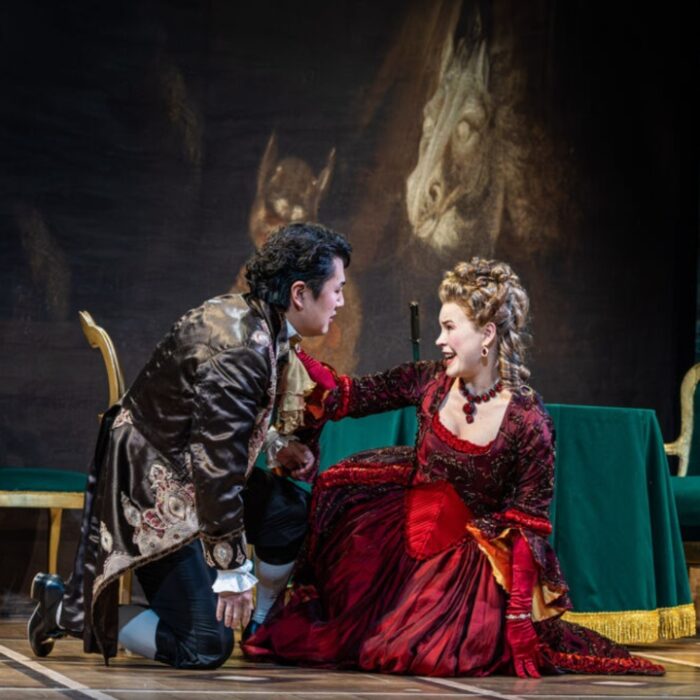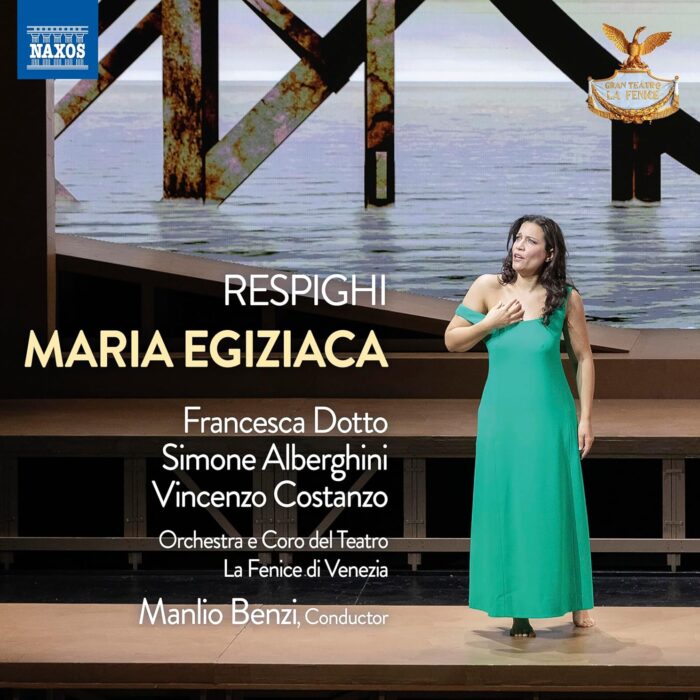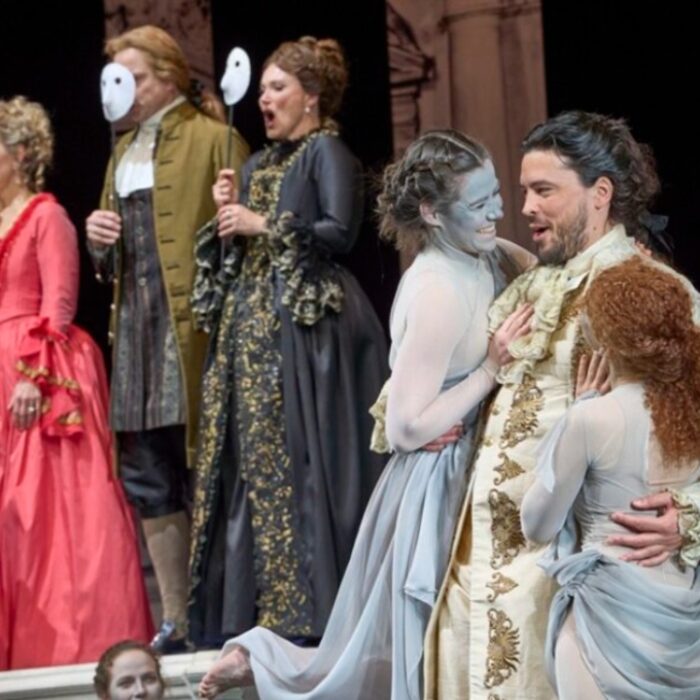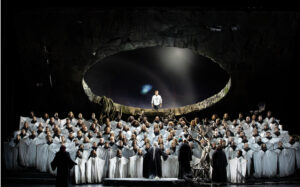
Metropolitan Opera 2022-23 Review: Lohengrin
Principals and Chorus take the Met’s new production into the heavens.
By Jennifer PyronPhoto Credit: Ken Howard
The Met Opera presented Wagner’s “Lohengrin” with tenor Piotr Beczała, Wagnerian sopranos Tamara Wilson and Christine Goerke, under the direction of François Girard, and Maestro Yannick Nézet-Séguin, for the 2023 season opening on February 26th.
“Lohengrin” was first performed in Weimar, Germany, in 1850 at the Staatskapelle Weimar, under the direction of Franz Liszt. However, the composer, Richard Wagner, was not present at the debut because he had been exiled due to his part in the May 1849 Uprising in Dresden. It was not until 1861 that he attended his first full performance, but by that time, “Lohengrin” was already a success. In fact, “Lohengrin” became an entry point of interest to Wagner’s genius for many.
Inspired by the legend of Lohengrin, from the 13th-century German romance Parzival, Wagner’s composition echoes the history of antithesis between human natures and perspectives. It is also important to note the Met Opera’s decision to bring “Lohengrin” back to its stage, after 17 years, in direct correlation to our current historical times. The opening performance took place one year after Russia’s invasion of Ukraine. The Met Opera’s continued efforts to honor Ukraine and its people were felt at this opening and marked what hopefully will be a turning point towards resolving conflicts both internally and externally through the power of art.
Celestial Voices
The opening projections were bright and full of life as they depicted the moon’s cycles in rotating frames above the stage. These references illuminated what appeared to be a very large circular opening in the middle of a dense platform hanging above. A portal for all to see the beyond that was becoming. As the projections further evolved, Yannick Nézet-Séguin conducted the Met orchestra with thoughtful sensitivity that evoked a mystical and miraculous overture. This was a historical start to a modern depiction of Wagner’s awe-inspiring Gesamtkunstwerk, “total work of art.”
Peter Flaherty, a director and interactive artist who specializes in kinematic projection mapping, demonstrated his mastery in creating the motion of celestial bodies and collections of such bodies in his work as projection designer for this production. Flaherty was also the projection designer for “Parsifal” at the Met in 2013. His collaboration with François Girard was described as revolutionary back then. And so, for this intrepid duo to continue a decade later with ‘Lohengrin,’ created the perfect sequence.
The synopsis began in Antwerp, Belgium, sometime between 925 and 933. The peoples of Brabant were in conflict, and King Heinrich, performed by bass Günther Groissböck, prepared his troops for battle. Groissböck sang with supreme fortitude. His voice was direct in its effectiveness in awakening the Met opera chorus in a unified effort. Count Friedrich von Telramund, performed by bass-baritone Evgeny Nikitin, accused his young ward, Elsa, of murder. In this opening scene, both Groissböck and Nikitin sang with a guttural force that the audience members could feel. Maestro Nézet-Séguin conducted these energies back to the Met opera chorus members, and it was as though every voice on stage lifted into the projected galaxies above. It was also at this moment when the set design synthesized with the overall complexities of this opera. Designer Tim Yip’s creation of a root-laden wall encompassed the stage and invited mysterious and deeper thoughts about human nature and the connectedness of multiple perspectives.
In the middle of Act one, Elsa, performed by Wagnerian soprano Tamara Wilson, told about a dream she had of a miraculous knight. She prayed for defense when accused of murder and evoked the spirit of Lohengrin. This is when The Herald, performed by baritone Brian Mulligan, announced Lohengrin’s entrance. Tenor Piotr Beczała entered the stage by walking through the large portal and down the stairs that separated the chorus members. Beczała’s spiritual transformation as Lohengrin was otherworldly and yet nostalgic. It was as though Beczała had been in this role lifetimes before. His voice was pure and truly captivating. His eyes radiated hope and sparkled through the darkness.
Tamara Wilson’s voice also took on another level of interpretation with Piotr Beczała on stage, and the Met Opera Chorus responded with precision and gusto. One might have felt as though the heavens were real at this moment, as the performers elicited true joy at being able to perform such a special work on an unforgettable date. This was an honorable and very thoughtful message of reinforced power that one can only hope enlivens and encourages Ukraine’s unimaginable efforts to overcome Putin’s Russia. The awareness of this strong message further fueled the next two acts to come.
Goerke Shines
Wagnerian soprano Christine Goerke awakened the depths of this opera when she sang with Tamara Wilson in Act two. The two women represented two sides of human nature that equally play a role in the balance of life. However, in this performance, Goerke’s voice developed into another category of personification, and one might have felt like they were witnessing history being made at the Met. Goerke was on fire. Her entire presence shifted Act two into a world of her own.
In Act three, both Beczała and Wilson sang with grace and profound beauty. Lohengrin’s unconditional love for Elsa was the embodiment of a soul’s love for the self, and the two celebrated their infinite love for one another. Director François Girard’s “Lohengrin” was a Gesamtkunstwerk, and in this final act, he pieced together “Parsifal’s” interconnection between magical realms and the human world. The entire opera developed over time with divine calculation. By the end, audience members were on the edge of their seats and stood immediately in appreciation of such an exquisite production. The Met Opera’s 2023 “Lohengrin” was a catalytic example of art history in the making. The power of great art became the true power of all.
